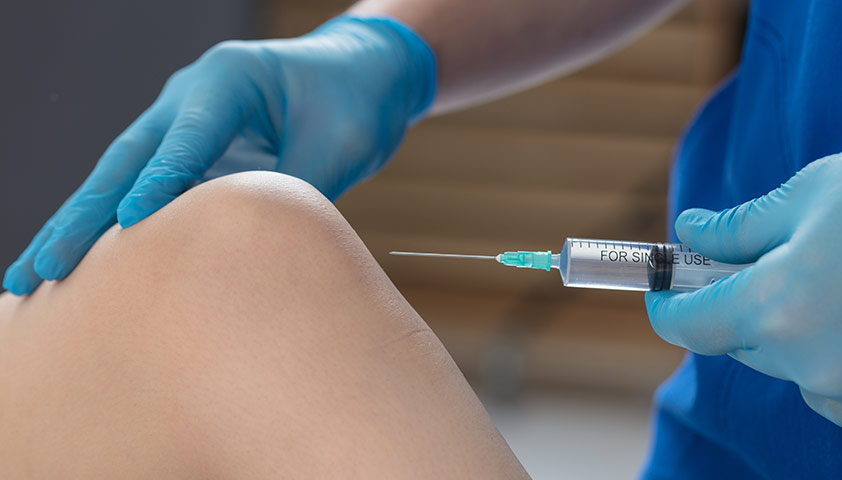Knee Injections: How They Work

Knee pain is a common condition affecting millions of people worldwide. It can result from a wide variety of causes, including osteoarthritis, rheumatoid arthritis, bursitis, injuries, and overuse. One increasingly popular treatment option for managing chronic or acute knee pain is knee injections.
These minimally invasive procedures offer targeted relief and can be a valuable part of a comprehensive treatment plan. But how do they work? This article delves into the different types of injections, their mechanisms, benefits, and potential drawbacks.
Why Are Knee Injections Used?
The knee is a complex joint that bears much of the body’s weight and is involved in nearly every lower-body movement. Because of its structure and function, it is particularly vulnerable to injury and degenerative diseases like osteoarthritis.
When conservative measures like physical therapy, oral medications, or lifestyle changes fail to adequately control symptoms, injections can offer a more direct, localized solution. Knee injections are often recommended to:
- Reduce inflammation
- Alleviate pain
- Improve mobility
- Delay or avoid surgery
- Support tissue healing (depending on the type)
Types of Knee Injections
There are several types of injections, each working through different mechanisms. The most commonly used include:
1. Corticosteroid Injections
Mechanism of Action:
Corticosteroids, often referred to simply as “steroids,” are powerful anti-inflammatory medications. When injected directly into the knee joint, they reduce the production of inflammatory chemicals and suppress the immune response in the area. This leads to decreased swelling, pain, and stiffness.
Benefits:
- Rapid pain relief
- Reduction of inflammation
- Effects can last from weeks to several months
Limitations:
- Not a cure; treats symptoms only
- Repeated use may weaken joint tissues over time
- Relief duration tends to decrease with each subsequent injection
2. Hyaluronic Acid (Viscosupplementation) Injections
Mechanism of Action:
Hyaluronic acid (HA) is a naturally occurring substance in joint fluid that helps lubricate and cushion the joint. In people with osteoarthritis, the natural HA breaks down and becomes less effective. Injecting synthetic HA can help restore this lubrication, improving movement and reducing pain.
Benefits:
- Improves joint lubrication
- May delay the need for surgery
- Typically lasts longer than corticosteroids (up to 6 months)
Limitations:
- Not effective for everyone
- It may take several weeks to show benefits
- Often more expensive than other options
3. Platelet-Rich Plasma (PRP) Injections
Mechanism of Action:
PRP injections involve concentrating platelets from the patient’s blood and injecting them into the knee. Platelets contain growth factors that can stimulate tissue repair and reduce inflammation.
Benefits:
- May promote natural healing
- Fewer side effects (uses the patient’s blood)
- Growing evidence of effectiveness, especially for early arthritis
Limitations:
May not be covered by insurance
Results can vary depending on the technique and severity of the condition
Requires processing blood before injection
4. Stem Cell Therapy
Mechanism of Action:
Stem cells are capable of differentiating into various tissue types, including cartilage. Stem cell injections, often derived from bone marrow or fat tissue, aim to regenerate damaged tissues and reduce inflammation in the knee.
Benefits:
- Potential for joint regeneration
- Long-term relief in some patients
- Non-surgical alternative for younger patients
Limitations:
- High cost and limited insurance coverage
- Still under research; long-term effects unclear
- Not FDA-approved for all uses
5. Genicular Nerve Blocks and Radiofrequency Ablation
Mechanism of Action:
Although not injections into the joint itself, genicular nerve blocks involve injecting anesthetic near nerves around the knee to block pain signals. In cases where this works, a follow-up treatment called radiofrequency ablation may provide longer-term relief.
Benefits:
- Effective for chronic knee pain, especially post-surgical
- Targets nerve pathways, not joint tissue
- Minimally invasive
Limitations:
- Doesn’t treat the underlying cause
- Not suitable for inflammatory arthritis
- May need repeated treatments
- What to Expect During the Procedure
Knee injections and tennis elbow injections are usually performed in a clinical setting and take less than 30 minutes. The typical process includes:
Preparation: The knee is cleaned and sterilized.
Guidance: In some cases, ultrasound or fluoroscopy is used to ensure accurate needle placement.
Injection: The medication is injected directly into the knee joint.
Post-care: Patients are usually advised to rest for a short period and avoid strenuous activity for 24–48 hours.
Most people can return to normal activities quickly, although mild swelling or discomfort at the injection site is possible.
How Effective Are Knee Injections?
Effectiveness varies based on the type of injection, the underlying cause of knee pain, and individual factors such as age, weight, and activity level.
Corticosteroids: Often effective for short-term relief, especially in cases of inflammatory arthritis or acute flare-ups.
Hyaluronic Acid: More effective in mild to moderate osteoarthritis, but benefits may be limited in advanced cases.
PRP and Stem Cells: Promising for early arthritis and younger patients, but still under investigation.
Nerve Blocks: Best suited for those not responding to conventional therapies or post-surgical pain.
Risks and Side Effects
While injections are generally safe, they do carry some risks:
- Infection
- Bleeding or bruising
- Allergic reaction (rare)
- Worsening of pain temporarily (a “flare”)
- Joint damage with repeated steroid injections
It is essential to have the procedure performed by a trained medical professional and to follow post-injection instructions closely.
Are Injections Right for You?
Injections are not a one-size-fits-all solution. The choice of treatment depends on several factors, including:
- Diagnosis (e.g., osteoarthritis vs. ligament injury)
- Severity of symptoms
- Age and activity level
- Medical history and other health conditions
- Response to previous treatments
Consultation with an orthopedic specialist, rheumatologist, or pain management physician can help determine the most appropriate injection type for your specific needs.
Conclusion
Knee injections are an important tool in the management of knee pain, offering options that range from inflammation control to potential joint regeneration. While they are not cures, they can significantly improve quality of life, reduce pain, and delay or avoid more invasive interventions like surgery. As with any medical treatment, a personalized approach—based on diagnosis, patient goals, and expert guidance—is key to achieving the best outcomes.


